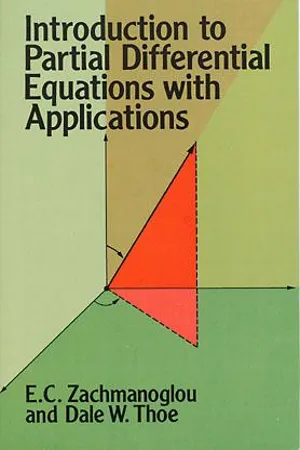
Introduction to Partial Differential Equations with Applications
- 432 pages
- English
- ePUB (mobile friendly)
- Available on iOS & Android
Introduction to Partial Differential Equations with Applications
About this book
This book has been widely acclaimed for its clear, cogent presentation of the theory of partial differential equations, and the incisive application of its principal topics to commonly encountered problems in the physical sciences and engineering. It was developed and tested at Purdue University over a period of five years in classes for advanced undergraduate and beginning graduate students in mathematics, engineering and the physical sciences.
The book begins with a short review of calculus and ordinary differential equations, then moves on to explore integral curves and surfaces of vector fields, quasi-linear and linear equations of first order, series solutions and the Cauchy Kovalevsky theorem. It then delves into linear partial differential equations, examines the Laplace, wave and heat equations, and concludes with a brief treatment of hyperbolic systems of equations.
Among the most important features of the text are the challenging problems at the end of each section which require a wide variety of responses from students, from providing details of the derivation of an item presented to solving specific problems associated with partial differential equations. Requiring only a modest mathematical background, the text will be indispensable to those who need to use partial differential equations in solving physical problems. It will provide as well the mathematical fundamentals for those who intend to pursue the study of more advanced topics, including modern theory.
Frequently asked questions
- Essential is ideal for learners and professionals who enjoy exploring a wide range of subjects. Access the Essential Library with 800,000+ trusted titles and best-sellers across business, personal growth, and the humanities. Includes unlimited reading time and Standard Read Aloud voice.
- Complete: Perfect for advanced learners and researchers needing full, unrestricted access. Unlock 1.4M+ books across hundreds of subjects, including academic and specialized titles. The Complete Plan also includes advanced features like Premium Read Aloud and Research Assistant.
Please note we cannot support devices running on iOS 13 and Android 7 or earlier. Learn more about using the app.
Information






Table of contents
- Cover
- Title Page
- Copyright Page
- Preface
- Contents
- Chapter I
- Chapter II
- Chapter III
- Chapter IV
- Chapter V
- Chapter VI
- Chapter VII
- Chapter VIII
- Chapter IX
- Chapter X
- Guide to further study
- Bibliography for further study
- Answers to selected problems
- Index